Before you decide to buy a guitar, you’ll need to decide if you want an acoustic guitar, an electric guitar, or an acoustic-electric.
![Guitar body and wood types- what to look for when buying a guitar [full guide]](https://neaera.com/wp-content/uploads/2022/06/Guitar-body-and-wood-types-what-to-look-for-when-buying-a-guitar-full-guide-1024x576.png)
Electric solid-body guitars are those that have no chambers or holes and the entire body is constructed of solid wood.
Semi-hollow describes a guitar’s body that has soundholes in it, typically two sizable ones. The body of an acoustic guitar is hollow.
When shopping for a guitar, it’s important to know what to look for in order to find the best one for your needs.
Two of the most important factors to consider are body shape and tonewood. The guitar body shape and the wood it’s made of have a big impact on the sound of your guitar.
This article will teach you all about guitar body types and materials so that you can make an informed decision when purchasing your next guitar.
Types of guitar bodies
There are three main types of guitar bodies: solid body, hollow body, and semi-hollow body.
Solid-body guitars are electric guitars and also the most popular type – they’re durable, versatile, and relatively affordable.
Hollow body guitars are acoustic guitars. There’s a semi-acoustic guitar known as the archtop or jazz guitar and it has a hollow body but I’ll get into that soon.
Semi-hollow body guitars are electric guitars that have sound holes. They’re less common than solid-body guitars but offer a unique sound.
Guitar bodies are made of wood. Electric guitars can have various finishes but acoustic guitars are usually natural wood.
The most common type of wood used for guitar bodies is maple, although mahogany and alder are also popular choices.
But let’s look at all of these aspects in more detail.
Hollow body guitar
A hollow guitar body is, as the name suggests, completely hollow.
The sound of a hollow body guitar is more mellow and acoustic than a solid body guitar.
They’re also more susceptible to feedback at high volumes but this can be avoided with the right amp settings.
Hollow body guitars are acoustic but there is a semi-acoustic guitar known as the archtop or jazz guitar.
The archtop has a hollow body but it also has a metal plate in the back to help reduce feedback.
There are certain pros and cons related to acoustic or hollow body guitars:
Pros of hollow-body guitars
- These guitars play the clear and soft tones very well
- The hollow body’s benefit in terms of sound and resonance is that it offers a natural tone.
- They can also play dirty tones very well
- Since they don’t need an amplifier, they are frequently used for live performances.
- They are ideal for unplugged sessions as well.
- Since acoustic guitars are often less expensive than electric guitars, they make excellent introductory instruments for beginners.
- Another benefit is that acoustic guitars are easier to maintain than electric guitars because you don’t need to worry about changing the strings as frequently and they don’t need as much maintenance.
Cons of hollow-body guitars
- The hollow body can create feedback issues if it’s not hooked up to the right amplifier.
- When unamplified, acoustic guitars can be challenging to hear in a group environment.
- They frequently have a shorter sustain.
Semi-hollow body guitar
A semi-hollow body guitar is, as the name suggests, semi-hollow.
They have a thin metal plate in the back and two small sound holes, also known as ‘f-holes.’
The sound of a semi-hollow body guitar is a cross between a hollow body and a solid body guitar.
They’re not as susceptible to feedback as a hollow body guitar but they’re not as loud either.
They’re a good choice for jazz, blues, and rock music.
Pros of semi-hollow body guitars
- A semi-hollow body guitar’s main advantage is that it combines the best features of both solid and hollow bodies, giving you the acoustic sound of one with the extra sustain of the other.
A very warm tone and pleasant resonant sound is produced by the semi-hollow guitar and that’s why many guitarists prefer it.
Similar to a solid body guitar, this one has a good bright and powerful tone. - Semi-hollow guitars are lighter and more pleasant to play for extended periods of time since there is a little less wood in the body.
Cons of semi-hollow body guitars
- A semi-hollow body guitar’s fundamental flaw is that its sustain isn’t as strong as a solid body guitar’s.
- Also, semi-hollow body guitars can cost a little bit more than solid-body guitars, which is another disadvantage.
- Although there are fewer feedback concerns with semi-hollow bodies than with solid ones, there are still a few due to the tiny holes in the body.
Solid-body guitar
A solid-body guitar is, as the name suggests, completely solid made from wood, and has no holes.
Solid-body guitars are electric guitars. They are adaptable and suitable for a range of musical styles, including rock, country, and metal.
Compared to semi-hollow body guitars, they have a much fuller sound and are less prone to feedback.
In terms of design, a solid-body electric can be made into almost any shape or style because the body contains no resonating chambers.
Therefore, a solid body guitar can be the way to choose if you’re looking for a distinctive shape.
Pros of solid body guitars
- The sound of a solid-body guitar is louder and more focused than a hollow-body guitar.
- They’re also less susceptible to feedback and are more durable.
- Solid-body guitars are the most popular type – they’re versatile and relatively affordable.
- Since wood density affects sustain, solid-body guitars have the most acoustic sustain of the three body types.
- The primary harmonics continue to resonate when a note is played, however secondary and tertiary harmonics tend to fade away quickly since there is no resonating chamber.
- Compared to hollow or semi-hollow body guitars, solid-body guitars can be amplified louder without worrying about feedback.
- They might also react to the effects faster.
- A sharper tone is produced because solid-body guitars are less prone to pickup feedback.
- Additionally, the bass end is more concentrated and tighter.
- On solid-body guitars, the trebly notes also typically sound better.
- A solid body guitar’s feedback is simpler to manage than a hollow body’s. You can also play the predictable tones more effectively.
Cons of solid body guitars
- Hollow and semi-hollow body guitars have more acoustic resonance than solid body guitars.
- A hollow-body can generate tones that are rich and warm, whereas a solid body cannot.
- A solid body electric guitar is heavier than a semi-hollow or hollow guitar since it is denser and constructed of more wood.
- Another drawback is that since a solid body depends on amplification, it won’t project the sound as well as a hollow or semi-hollow body if you want to play unplugged. Thus, you need to use an amp when playing a solid body electric guitar.
What’s the difference in sound between solid-body, hollow and semi-hollow body?
The difference in sound between these three types of bodies is quite significant.
Hollow and semi-hollow body guitars have a warmer, more mellow sound while solid-body guitars have a sharper, more focused sound.
Electric guitars with solid wood bodies have no sound holes. Due to the high density, this provides solid body guitars with a lot of sustain and minimal feedback.
Semi-hollow body electric guitars have “sound holes or f-holes”.
The guitar’s tone is made warmer and more acoustic because of these f-holes, which enable part of the sound to reverberate through the body.
Although not as much as a solid body guitar, semi-hollow body guitars nevertheless offer a lot of sustain.
Last but not least, acoustic guitars have a hollow-wood body. They have a very organic or natural sound as a result, but they lack the sustain of electric guitars.
Body weight
When choosing a guitar body, consider what type of music you want to play, as well as your budget and the guitar’s weight.
If you’re a beginner, solid-body guitars are a good place to start.
Solid-body guitars are the heaviest type of guitar, so if you’re looking for something lighter, hollow or semi-hollow body guitars may be a better option.
If you want to play a specific genre of music, like jazz or metal, then you’ll need to look for an electric guitar that’s designed for that style.
And if you’re looking for a bargain, check out used guitars – you might be able to find a great deal on a quality instrument.
Ever wondered why guitars are shaped the way they are to begin with?
Guitar body shapes: acoustic guitars
Acoustic guitars come in a variety of shapes. each with its own advantages and disadvantages.
The design of the guitar will impact both the tone and how comfy it feels in your hands.
Even guitars with the exact same shape might sound very differently thanks to the brand and model-specific design changes!
Here are the acoustic guitar body shapes:
Parlor guitar
The parlor body shape is the smallest of all the acoustic guitar body shapes. As a result, it has a very soft sound.
The parlor guitar is a good choice for players who want a very intimate sound.
It’s also the best guitar for fingerpicking thanks to the small size which makes it very comfortable to hold.
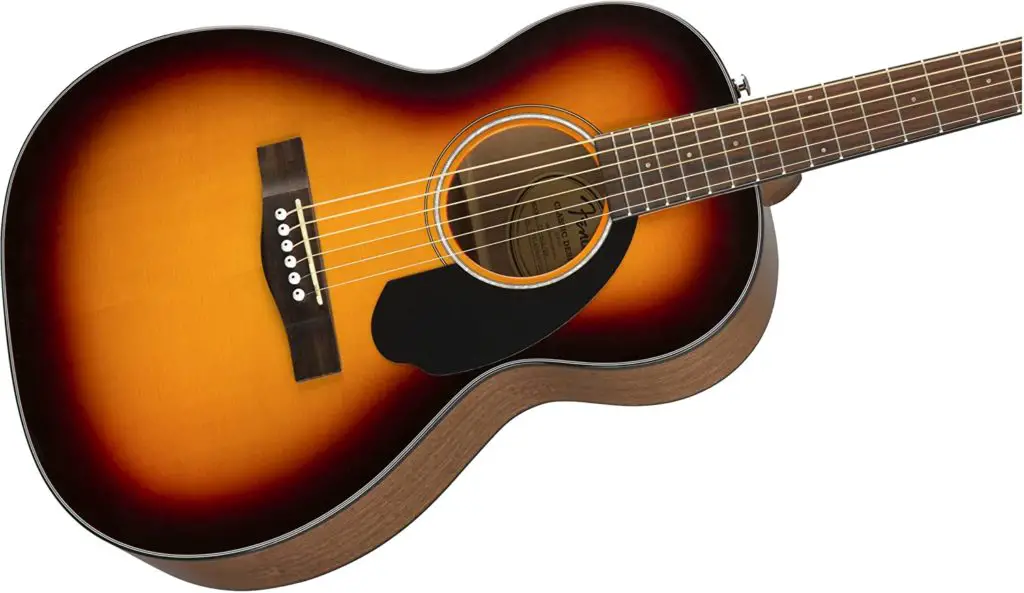
Parlor guitars (like this beauty from Fender) are not as popular as they used to be but there has been a recent resurgence in their popularity.
The small size of the parlor guitar makes it a great choice for players with small hands. It’s also a good choice for players who want a quiet guitar that won’t disturb others.
The sound is balanced, light, and quite focused compared to larger guitars.
Advantages of a parlor guitar
- Smaller body size
- Great for players with small hands
- Quieter sound
- Great for fingerpicking
- Balanced tones
Disadvantages of a parlor guitar
- Very soft sound
- May be too small for some players
Concert guitar
The concert body shape is smaller than the dreadnought and the grand auditorium. As a result, it has a softer sound.
The concert guitar, like this Yamaha model, is a good choice for players who want a delicate sound with a lot of brightness.
Like the parlor guitar, this one is also good for fingerpicking.
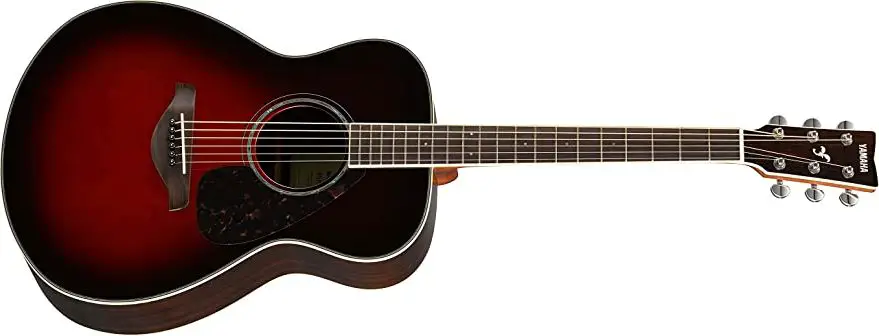
The small size of the concert guitar makes it a great choice for players with small hands.
The sound is focused, and the mid-range is more pronounced than on a dreadnought.
Advantages of a concert guitar
- Smaller body size
- Great for players with small hands
- Bright sound
- Works well for live performances
Disadvantages of a concert guitar
- Softer sound
- May be too small for some players
- May be too quiet
Also read: How Yamaha guitars stack up & 9 best models reviewed
Grand concert guitar
The classical guitar’s form, which Antonio Torres’ work helped standardize, is the foundation of the grand concert.
It’s one of the quietest guitar models. It is a fantastic all-around guitar because it has a strong mid-range register.
The Thomas Humphrey classical guitars and the majority of concert guitars are famous for their mid-range sound.
Its sound is neither as balanced nor brilliant as that of the smaller models nor is it as boomy or bassy as that of the bigger versions so it’s a great middle-ground.
The grand concert guitar has a narrower width at the waist in comparison to the dreadnought.
Advantages of a grand concert guitar
- Great for live performance
- Quiet
- Strong mid-range sound
Disadvantages of a grand concert guitar
- May be too quiet for some
- Not as popular
Classical acoustic guitar
The classical acoustic guitar is a nylon-string guitar. It’s called a “classical” guitar because it’s the type of guitar that was used in classical music.
The classical guitar has a softer sound than the steel-string acoustic guitar.
It’s a good choice for players who want a softer sound or who want to play classical music.
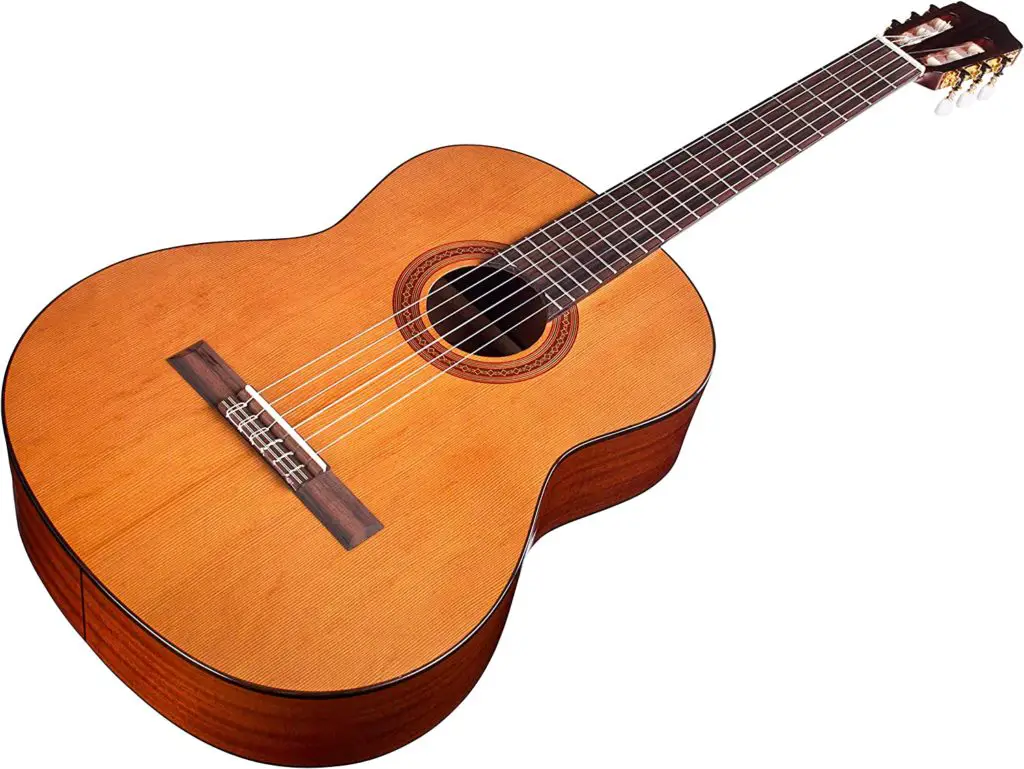
The shape of the classical guitar is similar to the concert guitar, but it’s usually a little larger.
Advantages of a classical acoustic guitar
- Softer sound
- Great for classical music
Disadvantages of a classical acoustic guitar
- Nylon strings may be difficult for some players
- Sound is not as loud as steel-string guitar
Auditorium guitar
The auditorium guitar is not to be confused with the Grand Auditorium, which is a different body shape.
The auditorium guitar is similar in size to the dreadnought, but it has a narrower waist and a shallower body.
The result is a guitar that’s comfortable to play and has great projection.
The sound of the auditorium is well-balanced, with a clear treble and a rich bass.
Advantages of an auditorium guitar
- Comfortable to play
- Great projection
- Well-balanced sound
Disadvantages of an auditorium guitar
- Can be a bit uncomfortable to play
- Not as loud
Grand auditorium guitar
The grand auditorium is a versatile body shape that’s somewhere between a dreadnought and a concert guitar.
It’s slightly smaller than a dreadnought, but it has a larger sound than a concert guitar.
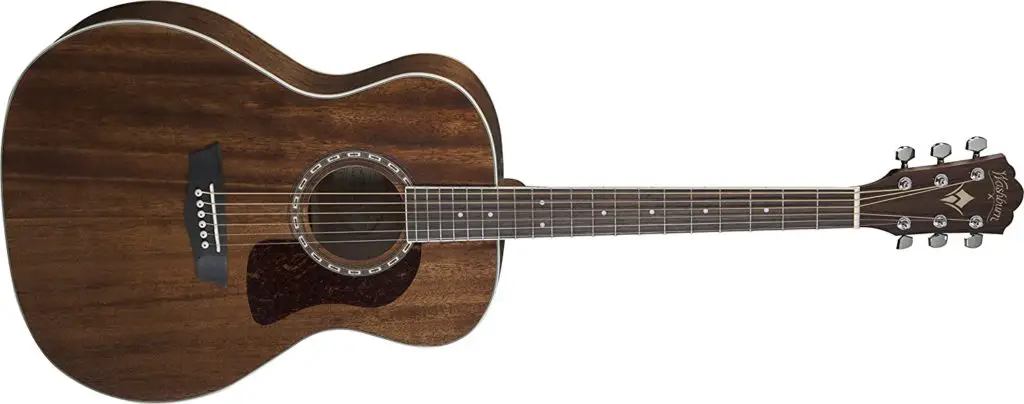
The grand auditorium is a good choice for players who want a versatile guitar that’s comfortable to play.
It’s a great choice for a variety of genres, including country, rock, and jazz.
Advantages of a grand auditorium guitar
- Versatile body shape
- Comfortable to play
- Great for a variety of genres
Disadvantages of a grand auditorium guitar
- This guitar has weak resonance
- Shorter sustain
Dreadnought guitar
The dreadnought is the most popular body shape for acoustic guitars. It’s a large guitar with a powerful sound often used to play on stage.
The dreadnought is well-balanced, making it comfortable to play for extended periods of time.
The large size of the dreadnought gives it a big sound, with plenty of projection. The bass is rich and full, while the highs are bright and clear.
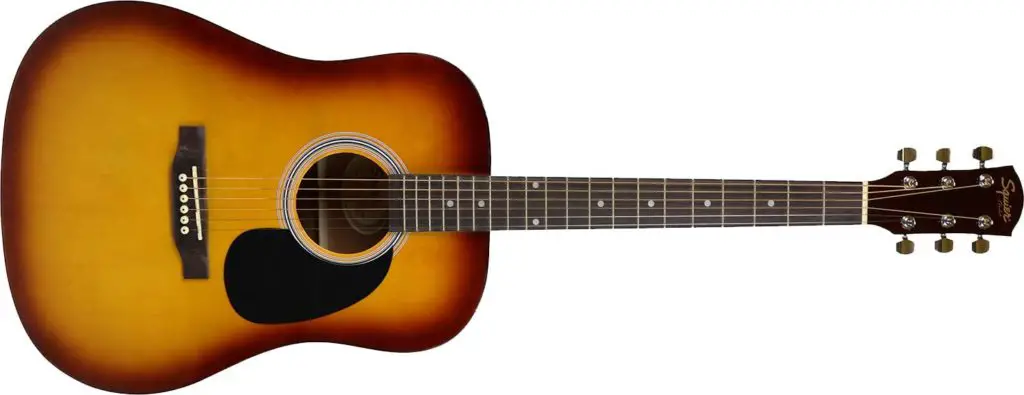
It’s a great type of guitar to accompany vocals and it’s also popular with flat-pickers.
Dreadnought guitars are great for a variety of genres, including country, rock, and blues.
If you’re looking for an all-around guitar, the dreadnought is a great choice.
Advantages of a dreadnought guitar
- Powerful sound
- Comfortable to play
- Great for a variety of genres
- Accompanies vocals well
Disadvantages of a dreadnought guitar
- Some dreadnoughts are very cheap and sound bad
- Sound can be inconsistent
Round-shoulder dreadnought guitar
The round-shoulder dreadnought is a variation of the traditional dreadnought. As the name suggests, the shoulders of the guitar are rounded.
The round-shoulder dreadnought shares many of the same advantages as the traditional dreadnought.
It has a powerful sound and is comfortable to play. It’s also great for a variety of genres.
The main difference between the two is that the round-shoulder dreadnought has a warmer sound.
If you’re looking for a dreadnought with a slightly different sound, the round shoulder is a great option.
Advantages of a round-shoulder dreadnought guitar
- Powerful sound
- Warm sound
- Comfortable to play
- Great for a variety of genres
Disadvantages of a round-shoulder dreadnought guitar
- Sound is a bit unusual
- Can be expensive
Jumbo guitar
The jumbo body shape is similar to the dreadnought, but it’s even larger with a wider body!
The added size gives the jumbo even more projection and volume.
The jumbo is a great choice for players who want the dreadnought sound, but with a little extra power.
This guitar has an excellent bass response so it sounds good when strumming.
Advantages of a jumbo guitar
- Even more projection and volume than a dreadnought
- Great for players who want a powerful sound
- Excellent for strumming
Disadvantages of a jumbo guitar
- May be too large for some players
- Can sound scrawny
Does the guitar shape influence sound and tone?
The overall guitar body shape has an effect on the sound and tone.
A smaller body guitar provides a more even sound. What this means is that the low, mid, and high sounds have a similar loudness so they’re balanced.
The larger the guitar size, lower bout will increase, and thus the lower pitches will be louder in comparison to high sounds.
This creates a sound that is less balanced than a smaller guitar.
However, it’s important to note that just because an acoustic guitar is less balanced doesn’t mean it’s not a good instrument.
Depending on musical style, some players prefer an imbalanced sound. For instance, a Blues player might want more low end for that characteristic growl.
Then, of course, there are instances where a heavy bass sounds much better and is needed on a certain recording.
If you play an accompaniment to a lead singer, the strumming might be drowned out if your sound is too even so a heavier bass is required.
All in all, it really depends on what you’re looking for in an acoustic guitar sound-wise.
In terms of tone, the shape of the guitar body has an effect on how the strings vibrate.
This means that certain shapes will emphasize certain tones over others.
For example, a dreadnought guitar will have a lot of low end because the large body allows the low frequencies to really resonate.
On the other hand, a smaller guitar like a parlor will have less low end and more high frequencies because the body doesn’t allow the low frequencies to vibrate as much.
So, if you’re looking for a guitar with a lot of low end, you might want to look for a dreadnought.
If you’re looking for a guitar with more high end, you might want to look for a parlor guitar.
Guitar body shapes: electric guitars
When it comes to electric guitars, there are a few popular shapes: the Stratocaster, the Telecaster, and the Les Paul.
Stratocaster
The Stratocaster is one of the most popular electric guitar shapes. It’s was used by a wide range of players, from Jimi Hendrix to Eric Clapton.
The Stratocaster has a slim body and a contoured neck. The result is a guitar that’s easy to play and has a great tone.

The Stratocaster is a good choice for players who want a versatile guitar that’s comfortable to play. It’s also a good choice for players who want a guitar with a “jangly” sound.
Telecaster
The Telecaster is another popular electric guitar shape. It was used by players like Keith Richards and Jimmy Page.
The Telecaster has a body that’s similar to the Stratocaster, but it has a “blunter” sound. The result is a guitar that’s great for players who want a “beefier” sound.
Les Paul
The Les Paul is a popular electric guitar shape that’s been used by players like Slash and Jimmy Page.
The Les Paul has a thick body that gives it a “fat” sound. The result is a guitar that’s great for players who want a “thick” sound.
Superstrat
The Superstrat is a type of electric guitar that’s based on the Stratocaster.
It was designed for players who want a guitar that can be used for a wide range of styles, from country to metal.
The Superstrat has a body that’s similar to the Stratocaster, but it has a more “aggressive” sound.
The result is a guitar that’s great for players who want a versatile guitar that can be used for a wide range of styles.
Odd-shaped electric guitars
There are also some electric guitars that have odd shapes. These guitars are often designed for specific purposes or styles of music.
Examples of odd-shaped electric guitars include:
- The Gibson Firebird
- The Rickenbacker 4001
- The Fender Jaguar
Gibson Firebird
The Gibson Firebird is an electric guitar that’s based on the shape of a bird. It was designed for players who want a guitar that’s easy to play and has a great tone.
Rickenbacker 4001
The Rickenbacker 4001 is an electric bass guitar that’s based on the shape of a cat. It was designed for players who want a bass guitar that’s easy to play and has a great tone.
Fender Jaguar
The Fender Jaguar is an electric guitar that’s based on the shape of a jaguar. It was designed for players who want a guitar that’s easy to play and has a great tone.
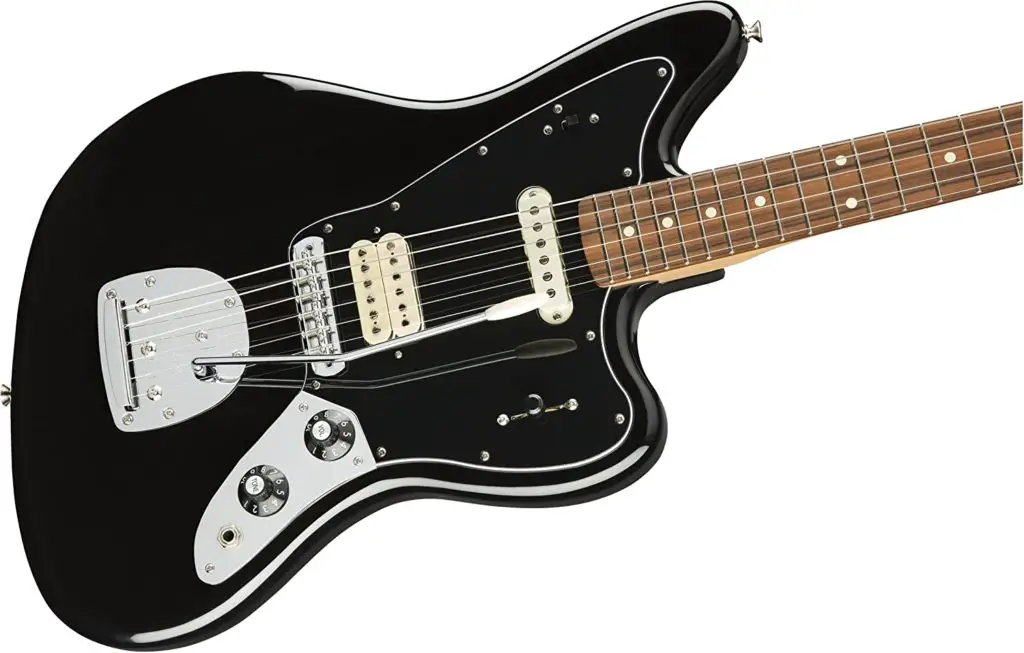
There are some others but you probably want to buy those if you’re already very familiar with electric guitars and want collector guitars.
Guitar body tone woods
Tonewood refers to the type of wood used in the body of the guitar. The type of tonewood can have a big impact on the sound of the guitar.
What wood is best for guitar body?
The most common woods are alder, ash, maple, spruce, cedar, koa, basswood, and mahogany.
The type of wood used for the guitar body has a big impact on the sound of the guitar. Different woods have different tonal characteristics.
Those looking for a full-bodied punch and twang like that of the Fender Strat prefer alder whereas those willing to spend more for a perfectly balanced sound will choose koa or maple.
Did you know there are also acoustic guitars made of carbon fiber? It makes them almost indestructable!
How to choose the right guitar body type for your needs
So, it’s time to choose a guitar… but what body type is best for you?
The benefits of each guitar body type
The benefits can vary depending on the style of music you want to play.
Here’s a quick guide to help you choose:
Acoustic guitars have a hollow body and are therefore the lightest type of guitar. They produce a warm, natural sound that is perfect for unplugged sessions and singer-songwriters.
A solid body guitar is the most versatile type of electric guitar. They can be used for any genre of music, from country to metal.
Solidbody guitars are also the easiest to keep in tune. They have no holes in the wooden body, so they don’t feedback as much as hollow body guitars.
Semi-hollow body guitars have two sound holes and a wooden block running down the middle of the body.
This design means they are not as susceptible to feedback as a hollow body guitar, but they are not as loud either.
They are a popular choice for jazz and blues players but rockers like them too!
Which guitar body type is best for beginners?
When you’re faced with the choice to get a solid-body or semi-hollow electric guitar, it comes down to what style of music you want to play.
If you want to play metal or rock, then a solid-body is the way to go. If you want something with more of a jazzy or bluesy sound, then a semi-hollow is the better option.
If you’re just starting out, we recommend getting an acoustic guitar. They are the easiest to learn to play and you don’t need an amplifier.
Now that you know the benefits of each guitar body type, it’s time to choose the right one for you!
Takeaway
There is no right or wrong answer when it comes to choosing a guitar body type. It all depends on your personal preference and the style of music you want to play.
If you’re a beginner, we recommend getting an acoustic guitar. They are the easiest to play and you don’t need an amplifier.
Once you’ve decided on the body type, the next step is to choose the right wood for your guitar.
The type of wood used for the body of a guitar can have a big impact on the overall sound.
You might also be interested in how the guitar wood finish impacts the sound and look of a guitar
I'm Joost Nusselder, the founder of Neaera and a content marketer, dad, and love trying out new equipment with guitar at the heart of my passion, and together with my team, I've been creating in-depth blog articles since 2020 to help loyal readers with recording and guitar tips.

